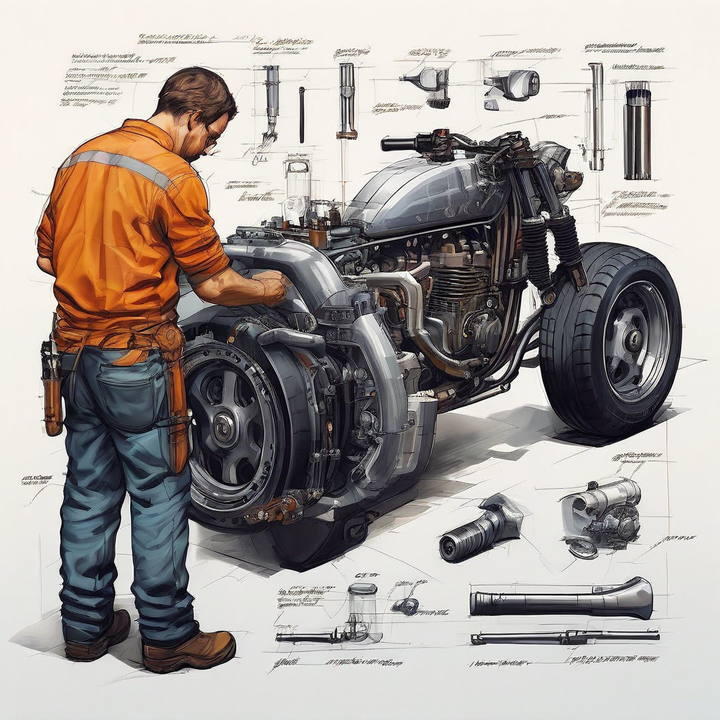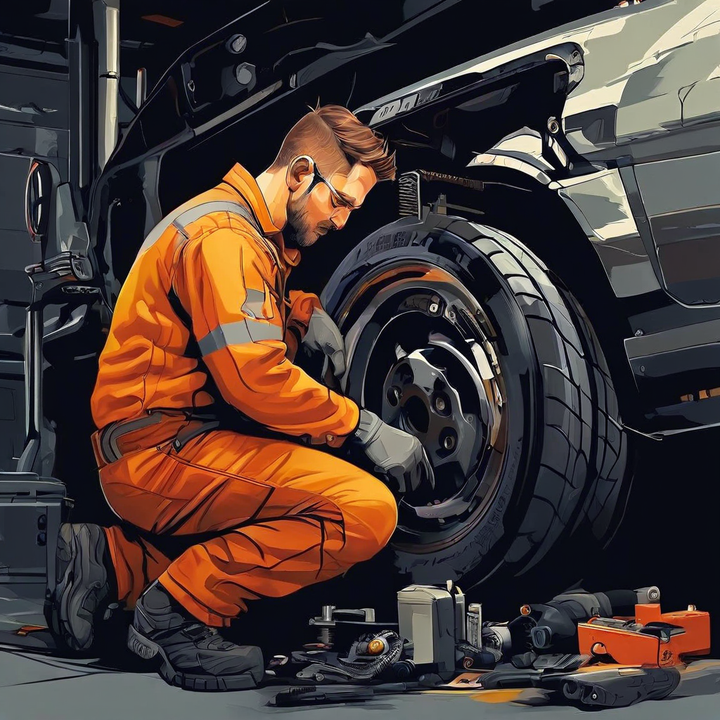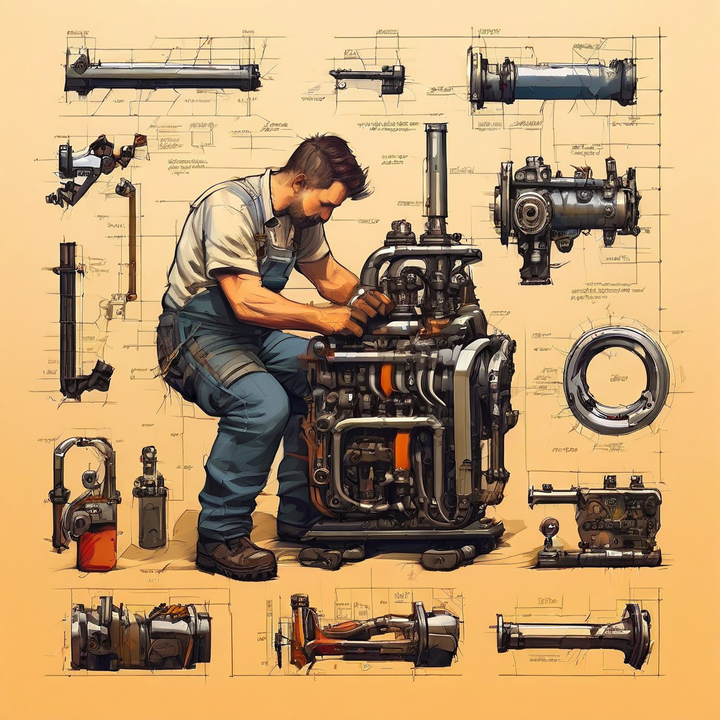


P03D6 is an OBD-II trouble code that indicates the pressure in cylinder 7 of the engine is too low. This can be caused by various issues related to the fuel injector, compression, or other mechanical problems specific to that cylinder.
When the P03D6 code rears its head, it's like a detective novel unfolding, and we need to gather clues to identify the culprit. Here are the most common suspects that could be causing this low-pressure conundrum:
| Suspect | Description |
|---|---|
| Faulty Fuel Injector | A clogged or malfunctioning fuel injector for cylinder 7 may not be delivering the proper amount of fuel, leading to a drop in cylinder pressure. |
| Valve Troubles | Stuck or leaking intake/exhaust valves for cylinder 7 can cause low compression and reduced cylinder pressure. |
| Worn Piston Rings | Worn or damaged piston rings in cylinder 7 can allow compression to leak, resulting in low cylinder pressure. |
| Head Gasket Failure | A blown head gasket can cause compression leaks between cylinders or into the cooling system, affecting cylinder pressure. |
| Low Compression | General wear and tear on cylinder 7 components (valves, piston, rings, etc.) can lead to low compression and reduced cylinder pressure over time. |
Just like a well-oiled machine, your engine relies on a precise fuel delivery system to keep the combustion process running smoothly. If the fuel injector responsible for cylinder 7 is clogged or malfunctioning, it might not be delivering the proper amount of fuel, leading to a drop in cylinder pressure. It's like trying to start a fire with a leaky gas can – you just won't get the desired ignition.
Valves are the gatekeepers of your engine's cylinders, controlling the flow of air and exhaust gases. If the intake or exhaust valves for cylinder 7 are stuck or leaking, it can cause low compression and reduced cylinder pressure. Imagine trying to inflate a balloon with a hole in it – no matter how hard you try, the pressure just won't build up.
Piston rings play a crucial role in sealing the combustion chamber and maintaining the necessary pressure. If the rings in cylinder 7 are worn or damaged, compression can leak, resulting in low cylinder pressure. It's like trying to keep water in a bucket with a cracked bottom – no matter how much you pour in, it just won't stay put.
The head gasket is the unsung hero that keeps everything sealed and separated. If it fails, compression can leak between cylinders or into the cooling system, affecting cylinder pressure. It's like having a leaky roof during a rainstorm – no matter how much you try to patch it up, the water just keeps finding its way in.
Over time, general wear and tear on the components of cylinder 7 (valves, piston, rings, etc.) can lead to low compression and reduced cylinder pressure. It's like an aging athlete – no matter how much they train, their performance just can't match their prime years.
Now that we've identified the potential suspects, it's time to put on our detective hats and gather evidence. Here's how we can diagnose the root cause of the P03D6 code:
Compression Test
Cylinder Leak-down Test
Fuel Injector Test
Visual Inspection
Just like a blood pressure check for your engine, a compression test will reveal if cylinder 7 is indeed suffering from low compression. Low readings are a telltale sign of internal issues like worn rings, valves, or even a head gasket failure. It's like taking an X-ray to see what's going on inside.
The compression test is performed by cranking the engine with the ignition disabled and measuring the pressure in each cylinder using a compression tester. The test should be done with the engine at operating temperature, and the results should be compared to the manufacturer's specifications.
| Compression Test Results | Possible Causes |
|---|---|
| Low compression in cylinder 7 | Worn piston rings, leaking valves, blown head gasket |
| Low compression in all cylinders | Worn engine components, excessive blow-by |
| Uneven compression readings | Mechanical issues specific to certain cylinders |
If the compression test raises suspicions, the cylinder leak-down test is our next line of investigation. This nifty procedure can pinpoint the source of compression leaks, whether it's from valves, rings, or the head gasket. It's like using a thermal camera to detect where the heat is escaping.
The leak-down test involves introducing compressed air into the cylinder and monitoring where the air escapes. By listening for air leaks and using specialized tools, the technician can determine if the leak is coming from the valves, piston rings, or head gasket.
We can't overlook the fuel injector as a potential suspect. By monitoring the fuel rail pressure during cranking or using a noid light, we can ensure that the fuel injector for cylinder 7 is firing properly and delivering the right amount of fuel. It's like checking the ammunition supply before a battle.
Fuel rail pressure test: The technician will monitor the fuel rail pressure while cranking the engine. If the pressure drops significantly when cylinder 7 is on its compression stroke, it could indicate a faulty injector.
Noid light test: A noid light is a simple tool that illuminates when the injector is energized, allowing the technician to visually confirm if the injector is firing.
Sometimes, the evidence is right in front of our eyes. By removing the valve cover, we can visually inspect the valves, pistons, and cylinder walls of cylinder 7 for any visible damage or excessive wear. It's like dusting for fingerprints at a crime scene – every little detail counts.
During the visual inspection, the technician will look for signs of:
Bent or damaged valves
Excessive carbon buildup
Scored or damaged cylinder walls
Broken or worn piston rings
Cracks or damage to the piston
Once we've cracked the case and identified the culprit, it's time to roll up our sleeves and get to work. Depending on the diagnosed cause, repairs may involve:
| Repair | Description |
|---|---|
| Fuel Injector Replacement | Replace the faulty fuel injector for cylinder 7 if it's not delivering proper fuel. |
| Valve Repair/Replacement | Stuck or leaking valves may require valve grinding, lapping, or replacement. |
| Piston Ring Replacement | Excessively worn piston rings will need to be replaced to restore compression. |
| Head Gasket Replacement | A blown head gasket requires removal of the cylinder head and replacement of the gasket. |
| Engine Overhaul | In severe cases of low compression due to excessive wear, an engine overhaul or rebuild may be necessary. |
If the fuel injector for cylinder 7 is indeed the root of the problem, we'll need to replace it with a fresh, fully-functioning unit. It's like swapping out a faulty spark plug to get the engine firing on all cylinders again.
The fuel injector replacement process typically involves:
Relieving the fuel system pressure
Disconnecting the fuel lines and electrical connectors
Removing the faulty injector
Installing the new injector and reconnecting the fuel lines and electrical connectors
Priming the fuel system and checking for leaks
Stuck or leaking valves may require some TLC in the form of valve grinding, lapping, or even replacement. It's like giving your engine a fresh set of lungs to breathe properly.
Valve grinding: This process involves resurfacing the valve face and seat to ensure a proper seal when the valve is closed.
Valve lapping: Lapping is a process of polishing the valve face and seat to create a smooth, leak-free surface.
Valve replacement: In cases of severe damage or wear, the valves may need to be replaced entirely.
Excessively worn piston rings will need to be replaced to restore compression and seal the combustion chamber once again. It's like giving your engine a new set of seals to keep everything tight and efficient.
Piston ring replacement typically requires:
Removing the cylinder head
Removing the pistons and connecting rods
Cleaning and inspecting the cylinder bores
Installing new piston rings
Reassembling the engine components
If the head gasket has failed, it's time for a major surgery. We'll need to remove the cylinder head and replace the gasket to ensure a proper seal and prevent compression leaks. It's like patching up a leaky roof to keep the elements out.
The head gasket replacement process involves:
Draining the cooling system and removing necessary components (intake manifold, exhaust manifold, etc.)
Removing the cylinder head
Cleaning and inspecting the cylinder head and engine block surfaces
Installing a new head gasket
Reassembling the engine components and refilling the cooling system
In severe cases of low compression due to excessive wear, an engine overhaul or rebuild may be necessary. It's like giving your engine a complete makeover, replacing all the worn-out components with fresh, new parts. It's a big job, but sometimes it's the only way to restore your engine to its former glory.
An engine rebuild typically involves:
Disassembling the entire engine
Inspecting and measuring all components for wear
Replacing worn or damaged parts (pistons, rings, bearings, valves, etc.)
Resurfacing or replacing the cylinder head and block
Reassembling the engine with new gaskets, seals, and lubricants
While repairs are sometimes inevitable, there are steps we can take to prevent the recurrence of the P03D6 code and keep our engines running smoothly:
Follow the manufacturer's recommended maintenance schedule for:
Spark plug replacement
Air filter changes
Engine oil and filter changes
Use high-quality fuel and avoid fuel additives that can damage injectors or cylinders.
Avoid overheating the engine, which can accelerate wear on internal components.
Address any engine issues promptly to prevent further damage.
Regular maintenance is like giving your engine a tune-up to keep it in top shape. Treat your engine to a balanced diet, and it will reward you with optimal performance. Keep your cool, and your engine will thank you. Nip problems in the bud before they become bigger headaches.
While knowledge is power, it's important to understand the potential financial implications of addressing the P03D6 code. The cost of repairs can vary significantly depending on the root cause and extent of the issue:
| Repair | Approximate Cost Range |
|---|---|
| Fuel Injector Replacement | $200 - $500 |
| Head Gasket Replacement | $1,000 - $2,000 |
| Engine Overhaul or Rebuild | $3,000 - $6,000 or more |
Replacing a single fuel injector may cost $200-$500, which is like investing in a new set of high-performance tires for your car.
A head gasket replacement can range from $1,000-$2,000, which is akin to a major home renovation project.
An engine overhaul or rebuild can be very expensive, often costing $3,000-$6,000 or more, depending on the vehicle and labor costs. This is like buying a brand-new engine for your car, but with the added benefit of retaining the character and history of your trusty ride.
While these costs may seem daunting, it's important to weigh them against the value of your vehicle and the potential consequences of ignoring the issue. After all, a well-maintained engine is the heart of your car, and investing in its health can save you from more expensive repairs down the road.
As we reach the end of our journey through the P03D6 code, I hope you've gained a deeper understanding of the intricate workings of your engine and the importance of addressing diagnostic codes promptly. Remember, your vehicle is a complex machine, and every code tells a story – a story that we, as mechanics, are tasked with unraveling.
Whether it's a faulty fuel injector, stuck valves, worn piston rings, or a head gasket failure, the P03D6 code is a call to action, a reminder that our engines need our attention and care. By following the diagnostic steps, considering the repair options, and implementing preventive measures, we can keep our vehicles running smoothly and extend their lifespan.
So, the next time you encounter the P03D6 code, don't panic. Instead, embrace the challenge, roll up your sleeves, and let your mechanical expertise shine. After all, decoding diagnostic codes is just another day in the life of a skilled mechanic, and every solved mystery brings us one step closer to mastering the art of automotive repair.
Happy wrenching, my friends!
The P03D6 code indicates that cylinder 7 has low pressure during the combustion cycle. This means there is an issue preventing cylinder 7 from building up proper compression.
Common causes include faulty fuel injectors, stuck or leaking valves, worn piston rings, blown head gasket, and excessive wear on internal components like valves, pistons, or cylinder walls.
You can perform a compression test, cylinder leak-down test, fuel injector test, and visual inspection of cylinder 7 components to pinpoint the specific issue.
Yes, a clogged or malfunctioning fuel injector for cylinder 7 can prevent proper fuel delivery, leading to low cylinder pressure and triggering the P03D6 code.
Depending on the diagnosed cause, repairs may involve replacing the fuel injector, valve repair/replacement, piston ring replacement, head gasket replacement, or potentially an engine overhaul.
Follow the manufacturer's recommended maintenance schedule, use high-quality fuel, avoid overheating the engine, and address any engine issues promptly to prevent further damage.
Yes, low compression in one cylinder can lead to engine misfires, rough idling, hesitation during acceleration, poor fuel economy, and potential catalytic converter damage if left unaddressed.
It is generally not recommended to continue driving with the P03D6 code active, as it can lead to further engine damage and potential safety issues if the compression problem worsens.
The cost can vary significantly depending on the root cause, ranging from a few hundred dollars for a fuel injector replacement to several thousand dollars for an engine overhaul or rebuild.
While some repairs like fuel injector or spark plug replacement may be feasible for experienced DIYers, more complex issues like valve repairs or engine overhauls typically require the expertise of a professional mechanic.

Miguel started tinkering with car radios as a teenager, fascinated by the intricate dance of wires and circuits. This passion led him to pursue a career as an automotive electrician. For the past 10 years, Miguel has tackled everything from flickering headlights to mysterious electrical gremlins. He thrives on troubleshooting electrical problems and enjoys sharing his knowledge to empower car owners to understand their vehicles better.



